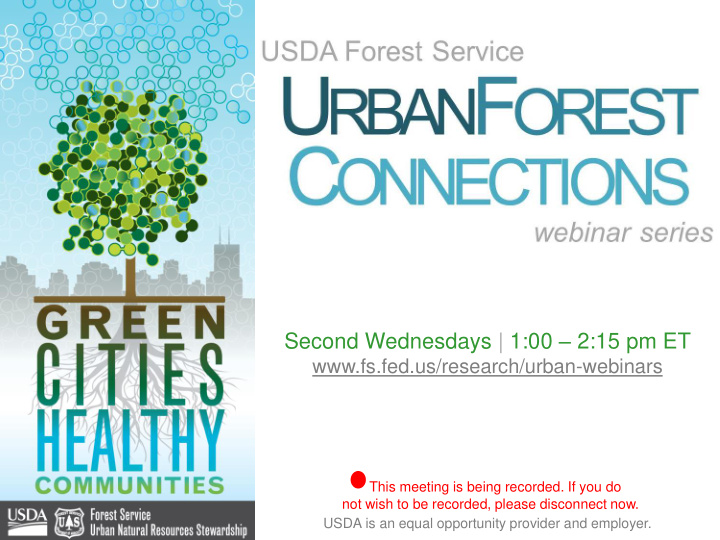



Second Wednesdays | 1:00 – 2:15 pm ET www.fs.fed.us/research/urban-webinars This meeting is being recorded. If you do not wish to be recorded, please disconnect now. USDA is an equal opportunity provider and employer.
Lara Roman Yekang Ko Pete Smith Research Ecologist Assistant Professor, Urban Urban Forestry Program Manager USDA Forest Service Planning Arbor Day Foundation University of Texas, Arlington
Part III: A Comparison of Survey Methods to Estimate Survivability of Energy-Saving Trees in Houston, Texas Pete Smith, Arbor Day Foundation
A Strategic Tree Planting Program
Landing Page: Enter Address & Powered by:
Tree Placement & Powered by:
Tree Selection & Energy Savings & Powered by:
Models of Tree Delivery Direct Delivery &
Models of Tree Delivery Local Pick-Up &
&
* Projected 20 year cumulative values &
Where are we going?
SurveyMonkey • Survey sent to 848 customers, accounting for all 1,591 trees • 267 surveys completed, 31.5% response rate! &
SurveyMonkey Results trees planted trees not planted elsewhere & DEAD or still in pot: 0.9% 5.8% • High ‘survivability’ trees planted elsewhere & ALIVE for the intended 10.5% address trees planted at recipient's address & DEAD • 11% of trees 6.4% distributed planted elsewhere trees planted at recipient's address & ALIVE • 6% of trees ‘not 76.4% Centerpoint Surveymonkey: planted’ Reported Disposition of Trees by Household (267 households) &
SurveyMonkey Centerpoint EST SurveyMonkey: Reported Stewardship 100% 469 450 91% 88% 90% 86% 426 420 400 405 80% 72% 350 70% 342 60% 300 60% 300 60% 277 250 50% 200 40% 150 30% 100 20% 50 10% 0 0% trees planted protected trunk trees planted away watered added mulch around avoided trees left unpruned in the ground during transport from weekly root zone staking trees power lines &
Field Audit • 320 trees randomly chosen • 289 tree audits completed = 18.2% sample &
Field Audit Results • 50% of trees ‘alive’ trees not planted or still in pot 10.4% at the registered address trees missing • 10% of trees ‘not from recipient’s address 39.1% planted ’ trees planted at recipient’s address & ALIVE 50.5% • 40% of trees ‘missing’ Centerpoint Field Audit: Survivability Statistics (289 trees) &
Field Audit Centerpoint EST Field Audit: Condition & Stewardship Statistics 99.3% 100.0% 100% 146 146 140 145 86.3% 90% 79.5% 126 120 77.4% 80% 74.0% 116 113 108 70% 100 60.3% 60% 88 80 50% 60 40% 30% 40 20% 20 10% 0 0% trees planted in trees w/o utility trees w/o trees w/o 'lower trees w/ trees w/ 'mulch' trees w/o trees w/o the ground ALIVE conflict 'fine twig dieback' trunk damage' 'vigor' rating 'staking' pruning ='good' evidence &
‘Survivability’ Comparison trees planted trees not planted trees not planted elsewhere & DEAD or still in pot or still in pot: 0.9% 10.4% 5.8% trees planted elsewhere & ALIVE 10.5% trees missing from recipient’s address trees planted at 39.1% recipient's address & DEAD trees planted at 6.4% recipient’s address & ALIVE 50.5% trees planted at recipient's address & ALIVE 76.4% Centerpoint EST Centerpoint EST Surveymonkey: Field Audit: Reported Disposition Survivability Statistics of Trees by Household &
Comparison of Methods SurveyMonkey • Quick and easy • Inexpensive • Supports good customer relations Field Audit • Requires planning, time & $$ • Credible third-party • Requires persistence &
What’s Next? • Continue monitoring using both methods &
What’s Next? • Continue monitoring using both methods • Improve systems to improve outcomes &
What’s Next? • Continue monitoring using both methods • Improve systems to improve outcomes • Evaluate planting location data &
What’s Next? • Continue monitoring using both methods • Improve systems to improve outcomes • Evaluate planting location data • Make regulatory case for Energy-Saving Trees &
Thanks! Lara Roman USFS Northern Research Station Yekang Ko University of Texas @ Arlington Jason Henning The Davey Institute Erica Smith Fichman Philadelphia Parks & Recreation Gretchen Riley & staff Texas A&M Forest Service
Recommend
More recommend